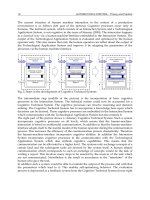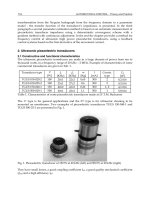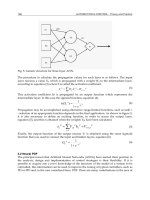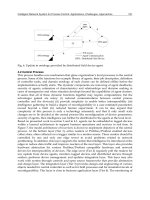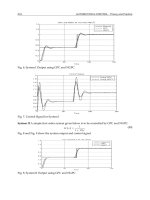Robot Manipulator Control Theory and Practice - Frank L.Lewis Part 2 pdf
Bạn đang xem bản rút gọn của tài liệu. Xem và tải ngay bản đầy đủ của tài liệu tại đây (418.15 KB, 32 trang )
Introduction to Control Theory24
This particular state-space representation is known as the controllable
canonical form [Kailath 1980], [Antsaklis and Michel 1997]. In general, a
linear, time-invariant, continuous-time system will have more than one input
and one output. In fact, u(t) is an m×1 vector and y(t) is a p×1 vector. The
differential equations relating u(t) to y(t) will not be presented here, but the
state-space representation of the multi-input/multi-output (MIMO) system
becomes
(2.2.6)
where A is n×n, B is n×m, C is p×n, and D is p×m. For the specific forms of
A, B, C, and D, the reader is again referred to [Kailath 1980], [Antsaklis and
Michel 1997]. A block diagram of (2.2.6) is shown in Figure 2.2.1a. Note
that the minimal number of states is equal to the required number of initial
conditions in order to find a unique solution to the set of differential
equations.
A more compact formulation of 2.2.2 and 2.2.3 is given by
(2.2.4)
where
(2.2.5)
Copyright © 2004 by Marcel Dekker, Inc.
Introduction to Control Theory26
EXAMPLE 2.2–2: Two-Platform System
a 2 platform system used to isolate experiments from external disturbances.
There are 2 inputs to the system given by u
2
which causes the ground to move
and u
1
which causes the platform m1 to move. The system also has 2 outputs,
namely the motion y
1
of platform m
1
and the motion y
2
of platform m
2
. The
experiments will be conducted on top of platform m
1
and therefore, one would
like to minimize the size of y
1
. The differential equations describing this system
are obtained using Newton’s second law:
A state-space formulation of this system can be obtained by choosing
Transfer Functions
Another equivalent representation of linear, time-invariant, continuous-time
systems is given by their transfer function, which relates the input of the
system u(t) to its output y(t) in the Laplace variable s or in the frequency
domain. It is important to note that the transfer function description has no
Copyright © 2004 by Marcel Dekker, Inc.
Consider the MIMO mechanical system shown in Figure 2.2.2 which represents
Introduction to Control Theory28
Y(s)=[C(sI-A)
-1
B+D] U(s)+C(sI-A)
-1
x(0) (2.2.8)
As mentioned previously, the transfer function is obtained as the relationship
between the input U(s) and the output Y(s) when x(0)=0, that is,
Y(s)=[C(sI-A)
-1
B+D] U(s). (2.2.9)
The transfer function of this particular linear, time-invariant system is given
by
P(s)=C(sI-A)
-1
B+D (2.2.10)
Y(s)=P(s)U(s) (2.2.11)
EXAMPLE 2.2–3: Transfer Function of Double Integrator
Consider the system of Example 2.2.1. It is easy to see that the transfer
function is
Discrete-Time Systems
In the discrete-time case, a difference equation is used to described the system
as follows:
(2.2.12)
where a
i
, b
i
, i=0,…,n are scalar constants, y(k) is the output, and u(k) is the
input at time k. Note that the output at time k+n depends on the input at
time k+n but not on later inputs; otherwise, the system would be non-
causal.
Copyright © 2004 by Marcel Dekker, Inc.
such that (see Fig.2.2.1)
2.2 Linear State-Variable Systems 29
The input-output equation then reduces to
y(k)=b
0
x
1
(k)+b
1
x
2
(k)+…+ b
n-1
x
n
(k)+u(k) (2.2.14)
A more compact formulation of (2.2.7) and (2.2.8) is given by
(2.2.15)
where
State-Space Representation
In a similar fashion to the continuous-time case, the following state-vector is
defined:
(2.2.13)
(2.2.16)
Copyright © 2004 by Marcel Dekker, Inc.
Introduction to Control Theory30
The MIMO case is similar to the continuous-time case and is given by
(2.2.17)
where A is n×n, B is n×m, C is p×n, and D is p×m.
In many practical cases, such as in the control of robots, the system is a
continuous-time system, but the controller is implemented using digital
hardware. This will require the designer to translate between continuous-
and discrete-time systems. There are many different approaches to
“discretizing” a continuous-time system, some of which are discussed in
problem is referred to [Åström and Wittenmark 1996], [Franklin et al.
1997].
EXAMPLE 2.2–4: Double Integrator in Discrete Time
Recall Example 2.2.1 which presented a model of the double integrator or
Newton’s system. One discrete-time version of the differential equation is
given by the following difference equation
where T is the sampling period in seconds. If we choose x
1
(k)=y(k) and
x
2
(k)=x
1
(k+1), we obtain the state-space description
Transfer Function Representation
In a similar fashion to the continuous-time case, a linear, time-invariant,
discrete-time system given by (2.2.17) may be described in the Z-transform
domain, from input U(z) to output Y(z) by its transfer function P(z) such
that
Y(z)=P(z)U(z)
Copyright © 2004 by Marcel Dekker, Inc.
Chapter 3. The interested reader in this very important aspect of the control
31
where
P(z)=C(zI-A)
-1
B+D
Note that the Z transform is used in the discrete-time case versus the Laplace
transform in the continuous-time case.
EXAMPLE 2.2–5: Tranfer Function of Discrete-Tiem Double Integrator
The transfer function of the Example 2.2.4 is given by
2.3 Nonlinear State-Variable Systems
In many cases, the underlying physical behavior may not be described using
linear state-variable equations. This is the case of robotic manipulators where
the interaction between the different links is described by nonlinear differential
capable of handling these systems, while the transfer function and frequency-
domain methods fail. In this section we deal with the nonlinear variant of
the preceding section and stress the classical approach to nonlinear systems
as studied in [Khalil 2001], [Vidyasagar 1992] and in [Verhulst 1997], [LaSale
and Lefschetz 1961], [Hahn 1967].
Continuous-Time Systems
A nonlinear, scalar, continuous-time, time-invariant system is described by a
nonlinear, scalar, constant-coefficient differential equation such as
(2.3.1)
where y(t) is the output and u(t) is the input to the system under consideration.
As with the linear case, we define the state vector x by its components as
follows:
2.3 Nonlinear State-Variable Systems
Copyright © 2004 by Marcel Dekker, Inc.
equations, as shown in Chapter 3. The state-variable formulation is still
Introduction to Control Theory32
The output equation then reduces to:
y(t)=x
1
(t) (2.3.3)
A more compact formulation of (2.3.2) and (2.3.3) is given by
(2.3.4)
where
U(t)=[u(t) u
(1)
(t)…u
(n-1)
(t)]
T
and
c=[1 0 0…0]. (2.3.5)
EXAMPLE 2.3–1: Nonlinear Systems
We present 2 examples illustrating such concepts:
1. Consider the damped pendulum equation
A state-space description is obtained by choosing x
1
=y, x
2
=y, leading to
(2.3.2)
Copyright © 2004 by Marcel Dekker, Inc.
The time history of y(t) is shown in Figure 2.3.1.
Introduction to Control Theory34
In this example, we will concentrate on writing the n coupled differential
equations into a state-space form. In fact, let a state vector x be
and the input vector be u=
τ
and suppose the output vector is y= q. Due to
Figure 2.3.2: Van der Pol Oscillator Time Trajectories: (a) Time history, (b) phase
plane.
Copyright © 2004 by Marcel Dekker, Inc.
some special properties of rigid robots (see Chapter 2), the matrix M(q) is
35
known to be invertible so that
or
(1)
where
Discrete-Time Systems
A nonlinear, scalar, discrete-time, time-invariant system is described by a
nonlinear, scalar, constant-coefficient difference equation such as,
where y(.) and u are as defined before. A simple choice of state variables will
lead to
(2.3.6)
or, more compactly, as
(2.3.7)
2.3 Nonlinear State-Variable Systems
Copyright © 2004 by Marcel Dekker, Inc.
Introduction to Control Theory36
where U(k) and c are defined similarly to those given in equation (2.3.4).
EXAMPLE 2.3–3: Logistics Equation
Consider the scalar system
which leads to the state-space representation
We will not emphasize the study of discrete nonlinear systems since robots
robot controllers are usually implemented using digital controllers. It will
therefore be advantageous to be able to translate between continuous-and
discrete-time description of nonlinear dynamical systems as discussed in
[åAström and Wittenmark 1995], [Franklin et al. 1997].
2.4 Nonlinear Systems and Equilibrium Points
In this section, we concentrate on systems described by (2.2.15) with the
additional requirement that u(t) is specified as a function of the state x(t),
i.e.
(2.4.1)
This will allow us to concentrate on the Analysis problem. We require a
few definitions which we shall now introduce.
(2.3.8)
Copyright © 2004 by Marcel Dekker, Inc.
are described by differential equations. However, as discussed in Chapter 4,
37
DEFINITION 2.4–1 The system (2.4.1) is said to be autonomous if f[t, x(t)]
is not explicitly dependent on time, i.e.
(1)
EXAMPLE 2.4–1: Nonautonomous System
Both systems introduced in Example 2.3.1 are autonomous while the system
described by
is not.
DEFINITION 2.4–2 A vector x
e
∈ᑬ
n
is a fixed or equilibrium point of (2.4.1)
at time t
0
if
(1)
EXAMPLE 2.4–2: Equilibrium Point of Autonomous System
The system described by
is autonomous and it has an equilibrium point at the origin of ᑬ
n
.
Note that:
• If a system is autonomous, then an equilibrium point at time t
0
is also an
equilibrium point at all other times.
2.4 Nonlinear Systems and Equilibrium Points
Copyright © 2004 by Marcel Dekker, Inc.
Introduction to Control Theory38
• If x
e
is an equilibrium point at time t
0
of the non-autonomous system
(2.4.1), then x
e
is an equilibrium point of (2.4.1) for all t
1
≥t
0
.
EXAMPLE 2.4–3: Equilibrium Point of Nonautonomous System
Consider the system
which is non-autonomous. It has NO EQUILIBRIUM POINTS. Although it
might seem that it has 2 equilibrium points x
e1
=-1 and x
e2
=1 at time t
0
=1.
However, these are not equilibrium points for times since at times t≥1 the
conditions of equilibrium does not hold.
Some books also used the terms stationary or singular points to denote
equilibrium points.
EXAMPLE 2.4–4: Damped Pendulum
Recall the pendulum in Example 2.3.1 and let us try to find its equilibrium
points. Note first that the system is autonomous so that we do not need to
specify the particular time t
0
and then note that the pendulum is at equilibrium
if both
x
2
=0 and sin(x
1
)=0
Therefore the equilibrium points are at
It is obvious that the pendulum is at equilibrium when it is hanging straight
up or straight down with zero velocity.
DEFINITION 2.4–3 An equilibrium point x
e
at t
0
of (2.4.1) is said to be
isolated if there is a neighborhood N of x
e
which contains no other equilibrium
points besides x
e
.
Copyright © 2004 by Marcel Dekker, Inc.
39
EXAMPLE 2.4–5: Equilibrium Points of Pendulum
The equilibrium points of the pendulum are isolated. On the other hand, a
system described by =0 has for equilibrium points any point in R and
therefore, none of its equilibrium points is isolated.
2.5 Vector Spaces, Norms, and Inner Products
In this section, we will discuss some properties of nonlinear differential
equations and their solutions. We will need many concepts such as vector
spaces and norms which we will introduce briefly. The reader is referred to
[Boyd and Barratt], [Desoer and Vidyasagar 1975], [Khalil 2001] for proofs
and details.
Linear Vector Spaces
In most of our applications, we need to deal with (linear) real and complex
vector spaces which are defined subsequently.
DEFINITION 2.5–1 A real linear vector space (resp. complex linear vector
space is a set V, equipped with 2 binary operations: the addition (+) and the
scalar multiplication (.) such that
2.5 Vector Spaces, Norms, and Inner Products
Copyright © 2004 by Marcel Dekker, Inc.
Introduction to Control Theory40
8. For each x∈V, we have 1.x=x where 1 is the unity in ᑬ (resp. in ).
EXAMPLE 2.5–1: Vector Spaces
The following are linear vector spaces with the associated scalar fields: ᑬ
ᒋ
with ᑬ, and
n
with .
DEFINITION 2.5–2 A subset M of a vector space V is a subspace if it is a
linear vector space in its own right. One necessary condition for M to be a
subspace is that it contains the zero vector.
We can equip a vector space with many functions. One of which is the
inner product which takes two vectors in V to a scalar either in ᑬ or in the
other one is the norm of a vector which takes a vector in V to a positive
value in ᑬ. The following section discusses the norms of vectors which is
then followed by a section on inner products.
Norms of Signals and Systems
A norm is a generalization of the ideas of distance and length. As stability
theory is usually concerned with the size of some vectors and matrices, we
give here a brief description of some norms that will be used in this book. We
will consider first the norms of vectors defined on a vector space X with the
associated scalar field of real numbers ᑬ then introduce the matrix induced
norms, the function norms and finally the system-induced norms or operator
gains.
Vector Norms
We start our discussion of norms by reviewing the most familiar normed
spaces, that is the spaces of vectors with constant entries. In the following,
||a|| denotes the absolute value of a for a real a or the magnitude of a if a is
complex.
DEFINITION 2.5–3 A norm ||·|| of a vector x is a real-valued function defined
on the vector space X such that
1. ||x||>0 for all x∈X, with ||x||=0 if and only if x=0.
2. ||
α
x||=|
α
|||x|| for all x∈X and any scalar
α
.
Copyright © 2004 by Marcel Dekker, Inc.
41
3. ||x+y||≤||x||+|y|| for all x,y ∈X,
EXAMPLE 2.5–2: Vector Norms (1)
The following are common norms in X=ᑬ
n
where ᑬ
n
is the set of n×1 vectors
with real components.
1. 1-norm:
2. 2-norm: also known as the Euclidean norm
3. p-norm:
4. 8-norm:
EXAMPLE 2.5–3: Vector Norms (2)
Consider the vector
Then, ||x||
1
=5, ||x||
2
=2 and ||x||∞=2.
We now present an important property of norms of vectors ᑬ
n
in which will
be useful in the sequel.
LEMMA 2.5–1: Let ||x||
a
and ||x||
b
be any two norms of a vector x∈ᑬ
ᒋ
. Then
there exists finite positive constants k
1
and k
2
such that
The two norms in the lemma are said to be equivalent and this particular
property will hold for any two norms on ᑬ
ᒋ
.
2.5 Vector Spaces, Norms, and Inner Products
Copyright © 2004 by Marcel Dekker, Inc.
Introduction to Control Theory42
EXAMPLE 2.5–4: Equivalent Vector Norms
1. It can be shown that for
2. Consider again the vector of Example 2.5.3. Then we can check that
Matrix Norms
In systems applications, a particular vector x may be operated on by a matrix
A to obtain another vector y=Ax. In order to relate the sizes of x and Ax we
define the induced matrix norm as follows.
DEFINITION 2.5–4 Let ||x|| be a given norm of x∈ᑬ
ᒋ
. Then each m×n matrix
A, has an induced norm defined by
where sup stands for the supremum.
It is always imperative to check that the proposed norms verify the
conditions of Definition 2.5.3. The newly defined matrix norm may also be
shown to satisfy
||AB||
i
≤ ||A||
i
||B||
i
for all n×m matrices A and all m×p matrices B.
Copyright © 2004 by Marcel Dekker, Inc.
43
EXAMPLE 2.5–5: Induced Matrix Norms
Consider the ∞ induced matrix norm, the 1 induced matrix norm and the 2
induced matrix norm,
where
max
is the maximum eigenvalue. As an illustration, consider the matrix
Then, ||A||
i1
=max(4, 4, 5)=5, ||A||
i2
=4.4576, and ||A||
i∞
= max(4, 7, 2)=7.
Function Norms
Next, we review the norms of time-dependent functions and vectors of
functions. These constitute an important class of signals which will be
encountered in controlling robots.
DEFINITION 2.5–5 Let f(.): [0, ∞)→R be a uniformly continuous function.
A function f is uniformly continuous if for any
⑀
>0, there is a
␦(⑀)
such that
Then, f is said to belong to L
p
if for p∈[1, ∞),
f is said to belong to L
∞
if it is bounded i.e. if
where sup f(t) denotes the supremum of f9t) i.e. the smallest number that is
2.5 Vector Spaces, Norms, and Inner Products
Copyright © 2004 by Marcel Dekker, Inc.
Introduction to Control Theory44
larger than or equal to the maximum value of f(t). L
1
denotes the set of signals
with finite absolute area, while L
2
denotes the set of signals with finite total
energy.
The following definition of the norms of vector functions is not unique. A
discussion of these norms is found in [Boyd and Barratt].
DEFINITION 2.5–6 Let denote the set of n×1 vectors of functions f
i
,
each of which belonging to L
p
. The norm of is
for p
⑀
[1, ∞) and
Some common norms of scalar signals u(t) that are persistent (i.e. lim
t→
∞
u(t)≠0) are the following:
1. which is valid for signals with
finite steady-state power.
2. ||u||∞=sup
t≥0
|u(t) which is valid for bounded signals but is dependent on
outliers.
3. which measures the steady-state average
resource consumption.
For vector signals, we obtain:
1.
2.
3.
Note that
On the other hand, if signals do not persist, we may find their L
2
or L
1
norms as follows:
1. which measures the total resource consumption
Copyright © 2004 by Marcel Dekker, Inc.
45
2. which measures the
total energy.
EXAMPLE 2.5–6: Function Norms
1. The function f(t)=e
-t
belongs to L
1
. In fact, ||e
-t
||
1
=1. The function
belongs to L
2
. The sinusoid f(t)=2sint belongs to L
∞
since its
magnitude is bounded by 2 and ||2sint||
∞
= 2.
2. Suppose the vector function x(t) has continuous and real-valued
components, i.e.
where [a, b] is a closed-interval on the real line R. We denote the set of such
functions x by
n
[a, b]. Then, let us define the real-valued function
where ||x(t)|| is any previously defined norm of x(t) for a fixed t. It can be
verified that ||x(.)|| is a norm on the set
n
[a, b] and may be used to compare
the size of such functions [Desoer and Vidyasagar 1975]. In fact, it is very
important to distinguish between ||x(t)|| and ||x(.)||. The first is the norm of a
fixed vector for a particular time t while the second is the norm of a time-
dependent vector. It is this second norm (which was introduced in definition
2.5.6) that we shall use when studying the stability of systems.
3. The vector f(t)=[e
-t
-e
-t
-(1+t)
-2
]
T
is a member of
. On the other hand,
f(t)=[e
-t
-e
-t
-(1+t)
-1
]
T
is a member of and .
In some cases, we would like to deal with signals that are bounded for finite
times but may become unbounded as time goes to infinity. This leads us to
define the extended L
p
spaces. Thus consider the function
(2.5.1)
then, the extended L
p
space is defined by
2.5 Vector Spaces, Norms, and Inner Products
Copyright © 2004 by Marcel Dekker, Inc.
Introduction to Control Theory46
where T<∞. We also define the norm on L
p
e as
Similar definitions are available for and the interested reader is referred to
[Boyd and Barratt], [Desoer and Vidyasagar 1975].
EXAMPLE 2.5–7: Extended L
p
Spaces
The function f(t)=t belongs to L
pe
for any p∈[1, ∞] but not to L
p
.
System Norms
We would like next to study the effect of a multi-input-multi-output (MIMO)
system on a multidimensional signal. In other words, what happens to a
time-varying vector u(t) as it passes through a MIMO system H? Let H be a
system with m inputs and l outputs, so that its output to the input u(t) is
given by
y(t)=(Hu)(t)
We say that H is L
p
stable if Hu belongs to whenever u belongs to and
there exists finite constants ␥>0 and b such that
If p=∞, the system is said to be bounded-input-bounded-output (BIBO) stable.
DEFINITION 2.5–7 The L
p
gain of the system H is denoted by ␥
p
(H) and is
the smallest ␥ such that a finite b exists to verify the equation.
Therefore, the gain ␥
p
characterizes the amplification of the input signal as
it passes through the system. The following lemma characterizes the gains of
linear systems and may be found in [Boyd and Barratt].
LEMMA 2.5–2: Given the linear system H such that an input u(t) results in
an output and suppose H is BIBO
stable, then
Copyright © 2004 by Marcel Dekker, Inc.
47
1.
2.
3.
EXAMPLE 2.5–8: System Norms
1. Consider the system
so that the impulse response is
(1)
Note that H(s) is BIBO stable. Then
2. Consider the system
where k
v
and k
p
are positive constants. The system is therefore BIBO stable.
Then
where e=2.7183 is the base of natural logarithms.
2.5 Vector Spaces, Norms, and Inner Products
Copyright © 2004 by Marcel Dekker, Inc.
Introduction to Control Theory48
This concludes our brief review of norms as they will be used in this book.
Inner Products
An inner product is an operation between two vectors of a vector space which
will allow us to define geometric concepts such as orthogonality and Fourier
series, etc. The following defines an inner product.
DEFINITION 2.5–8 An inner product defined over a vector space V is a
function <.,.> defined from V to F where F is either ᑬ or such that ᭙x, y,
z, ∈V
1. <x, y>=<y, x>* where the <.,.>* denotes the complex conjugate.
2. <x, y+z>=<x, y>+<x, z>
3. ,
4. <x, x>≥0 where the 0 occurs only for x=0
V
EXAMPLE 2.5–9: Inner Products
The usual dot product in ᑬ
n
is an inner product.
We can define a norm for any inner product by
(2.5.2)
Therefore a norm is a more general concept: A vector space may have a norm
associated with it but not an inner product. The reverse however is not true.
Now, with the norm defined from the inner product, a complete vector space
in this norm (i.e. one in which every Cauchy sequence converges) is known as
a Hilbert Space
Matrix Properties
Some matrix properties play an important role in the study of the stability of
dynamical systems. The properties needed in this book are collected in this
section. We will assume that the readers are familiar with elementary
Copyright © 2004 by Marcel Dekker, Inc.
49
DEFINITION 2.5–9 All matrices in this definition are square and real.
• Positive Definite: A real n×n matrix A is positive definite if x
T
Ax>0 for
all , x≠0.
• Positive Semidefinite: A real n×n matrix A is positive semidefinite if
xT
Ax≥0 for all .
• Negative Definite: A real n×n matrix A is negative definite if x
T
Ax<0 for
all , x≠0.
• Negative Semidefinite: A real n×n matrix A is negative semidefinite if x
T
Ax≤0 for all .
• Indefinite: A is indefinite if x
T
Ax>0 for some and x
T
Ax<0 for
other .
Note that
where A
s
is the symmetric part of A. Therefore, the test for the definiteness
of a matrix may be done by considering only the symmetric part of A.
THEOREM 2.5–1: Let A=[a
ij
] be a symmetric n×n real matrix. As a result,
all eigenvalues of A are real. We then have the following
• Positive Definite: A real n×n matrix A is positive definite if all its
eigenvalues are positive.
• Positive semidefinite: A real n×n matrix A is positive definite if all its
eigenvalues are nonnegative.
• Negative Definite: A real n×n matrix A is negative definite if all its
eigenvalues are negative.
• Negative Semidefinite: A real n×n matrix A is negative semidefinite if all
its eigenvalues are non-positive.
• Indefinite: A real n×n matrix A is indefinite if some of its eigenvalues are
positive and some are negative.
2.5 Vector Spaces, Norms, and Inner Products
Copyright © 2004 by Marcel Dekker, Inc.
Introduction to Control Theory50
THEOREM 2.5–2: Rayleigh-Ritz Let A be a real, symmetric n×n positive-
definite matrix. Let
min
be the minimum eigenvalue and
max
be the maximum
eigenvalue of A. Then, for any ,
THEOREM 2.5–3: Gerschgorin Let A=[a
ij
] be a symmetric n×n real matrix.
Suppose that
If all the diagonal elements are positive, i.e. a
ii
>0, then the matrix A is positive
definite.
EXAMPLE 2.5–10: Positive Definite Matrics
Consider the matrix
(1)
Its symmetric part is given by
(2)
This matrix is positive-definite since its eigenvalues are both positive (1.8377,
8.1623). Of course, Gershgorin’s theorem could have been used since the
diagonal elements of A
s
are all positive and
On the other hand, consider a vector x=[x
1
x
2
]
T
and its 2-norm, then
Copyright © 2004 by Marcel Dekker, Inc.




